6.2.3: Solid Geometric Figures and Objects
- Page ID
- 87302
6.2.3 Learning Objectives
- Find the volume of some common geometric objects
The Meaning and Notation for Volume
The product \(\text{(length unit)}\text{(length unit)}\text{(length unit)} = \text{(length unit)}^3\), or cubic length unit (cu length unit), can be interpreted physically as the volume of a three-dimensional object.
Definition: Volume
The volume of an object is the amount of cubic length units contained in the object.
For example, 4 cu mm means that 4 cubes, 1 mm on each side, would precisely fill some three-dimensional object. (The cubes may have to be cut and rearranged so they match the shape of the object.)
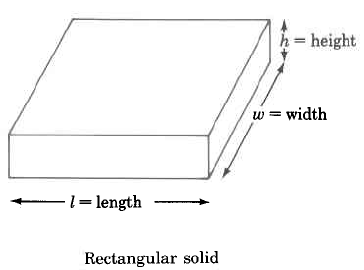
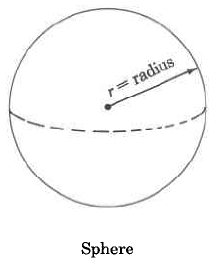
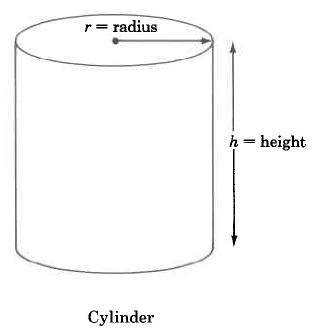
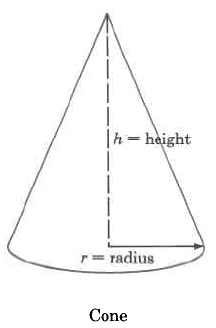
Volume Formulas
| Figure | Volume Formula | Statement | |
 |
Rectangular solid | \(\begin{array} {rcl} {V_R} & = & {l \cdot w \cdot h} \\ {} & = & {\text{(area of base)} \cdot \text{(height)}} \end{array}\) | The volume of a rectangular solid is the length times the width times the height. |
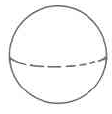 |
Sphere | \(V_s = \dfrac{4}{3} \cdot \pi \cdot r^3\) | The volume of a sphere is \(\dfrac{4}{3}\) times \(\pi\) times the cube of the radius. |
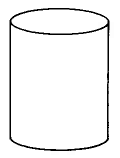 |
Cylinder | \(\begin{array} {rcl} {V_{Cyl}} & = & {\pi \cdot r^2 \cdot h} \\ {} & = & {\text{(area of base)} \cdot \text{(height)}} \end{array}\) | The volume of a cylinder is \(\pi\) times the square of the radius times the height. |
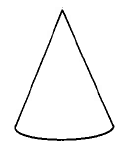 |
Cone | \(\begin{array} {rcl} {V_c} & = & {\dfrac{1}{3} \cdot \pi \cdot r^2 \cdot h} \\ {} & = & {\text{(area of base)} \cdot \text{(height)}} \end{array}\) | The volume of a cone is \(\dfrac{1}{3}\) times \(\pi\) times the square of the radius times the height. |
Finding Volumes of Some Common Geometric Objects
Example 1
Find the volume of the rectangular solid.
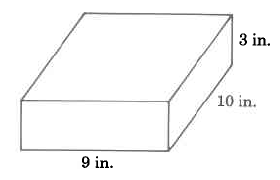
Solution
\(\begin{array} {rcl} {V_R} & = & {l \cdot w \cdot h} \\ {} & = & {\text{9 in} \cdot \text{10 in.} \cdot \text{3 in}} \\ {} & = & {\text{270 cu in}} \\ {} & = & {\text{270 in}^3} \end{array}\)
The volume of this rectangular solid is 270 cu in.
Example 2
Find the approximate volume of the sphere.
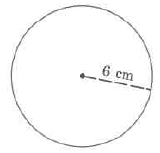
Solution
\(\begin{array} {rcl} {V_S} & = & {\dfrac{4}{3} \cdot \pi \cdot r^3} \\ {} & \approx & {(\dfrac{4}{3}) \cdot (3.14) \cdot \text{(6 cm)}^3} \\ {} & \approx & {(\dfrac{4}{3}) \cdot (3.14) \cdot \text{(216 cu cm)}} \\ {} & \approx & {\text{904.32 cu cm}} \end{array}\)
The approximate volume of this sphere is 904.32 cu cm, which is often written as 904.32 cm\(^3\).
Example 3
Find the approximate volume of the cylinder.
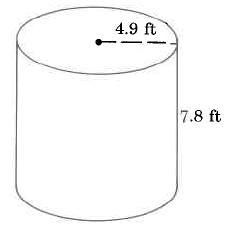
Solution
\(\begin{array} {rcl} {V_{Cyl}} & = & {\pi \cdot r^2 \cdot h} \\ {} & \approx & {(3.14) \cdot (\text{4.9 ft})^2 \cdot \text{(7.8 ft)}} \\ {} & \approx & {(3.14) \cdot (\text{24.01 sq ft}) \cdot \text{(7.8 ft)}} \\ {} & \approx & {(3.14) \cdot \text{(187.278 cu ft)}} \\ {} & \approx & {\text{588.05292 cu ft}} \end{array}\)
The volume of this cylinder is approximately 588.05292 cu ft. The volume is approximate because we approximated \(\pi\).
Example 4
Find the approximate volume of the cone. Round to two decimal places.
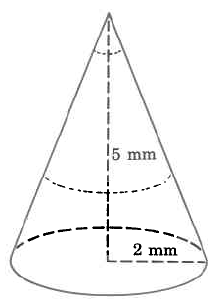
Solution
\(\begin{array} {rcl} {V_{c}} & = & {\dfrac{1}{3} \cdot \pi \cdot r^2 \cdot h} \\{} & \approx & {(\dfrac{1}{3}) \cdot (3.14) \cdot (\text{2 mm})^2 \cdot \text{(5 mm)}} \\ {} & \approx & {(\dfrac{1}{3}) \cdot (3.14) \cdot (\text{4 sq mm}) \cdot \text{(5 mm)}} \\ {} & \approx & {(\dfrac{1}{3}) \cdot (3.14) \cdot \text{(20 cu mm)}} \\ {} & \approx & {20.9\overline{3} \text{ cu mm}} \\ {} & \approx & {\text{20.93 cu mm}} \end{array}\)
The volume of this cone is approximately 20.93 cu mm. The volume is approximate because we approximated \(\pi\).
Try It Now 1
Find the volume of the rectangular solid.
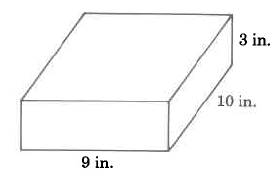
- Answer
-
21 cu in
Try It Now 2
Find the volume of the sphere. Use the \(\pi\) key on your calculator to find the approximate volume.
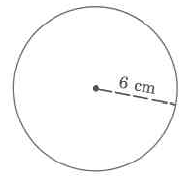
- Answer
-
904.32 cu ft
Try It Now 3
Find the volume of the cylinder. Use the \(\pi\) key on your calculator to find the approximate volume.
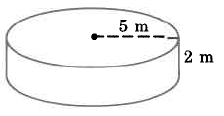
- Answer
-
157 cu m
Try It Now 4
Find the volume of the cone. Use the \(\pi\) key on your calculator to find the approximate volume.
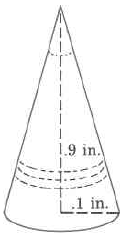
- Answer
-
0.00942 cu in
Finding the Volume of Composite Figures
Similar to finding the area of composite figures, we will first determine the separate shapes that the figure is made of. Then use the formulas for the volumes of the individual shapes and add them together.
Example 5
Find the approximate volume of the composite figure. Use the \(\pi\) key on your calculator to find the approximate volume if necessary. Round to two decimal places.
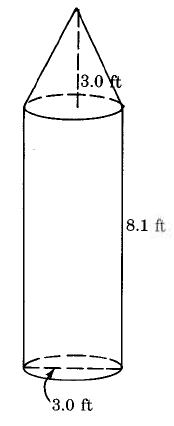
Solution
This shape is made up of a cone and a cylinder. We can tell from the base of the cylinder, that the diameter of the cone is 3.0 ft.
\(\begin{array} {rcl} {V} & = &{V_{cone}+V_{cylinder}}\\{}& = &{\dfrac{1}{3} \cdot \pi \cdot r^2 \cdot h+\pi \cdot r^2 \cdot h}\\{} & \approx & {(\dfrac{1}{3}) \cdot \pi \cdot (\text{1.5 ft})^2 \cdot \text{(3.0 ft)}+\pi \cdot \text{1.5 ft}^2 \cdot \text{8.1 ft.}}\\{} & \approx & {(\dfrac{1}{3}) \cdot \pi \cdot (\text{2.25 ft}^2) \cdot \text{(3.0 ft)}+\pi \cdot \text{2.25 ft}^2 \cdot \text{8.1 ft.}}\\{} & \approx & {(\dfrac{1}{3}) \cdot \pi \cdot \text{(6.75 cu ft)}+\pi \cdot \text{18.225 cu ft}}\\{} & \approx & {7.06858 \text{ cu ft}+57.25553\text{ cu ft}} \\{} & \approx & {\text{64.32 cu ft}} \end{array}\)
The volume of this figure is approximately 64.32 cu ft. The volume is approximate because we approximated \(\pi\).
Try It Now 6
Find the volume of the composite figure.
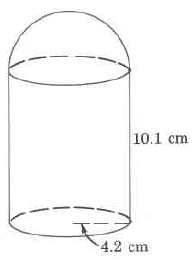
- Answer
-
This shape is composed of a hemisphere and a cylinder.
\(V\approx 870\) cu cm


